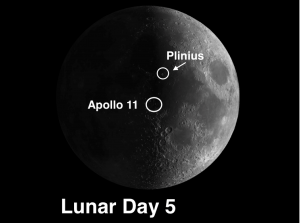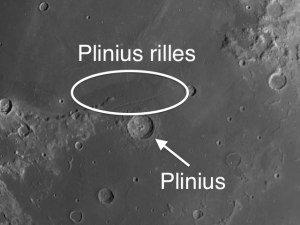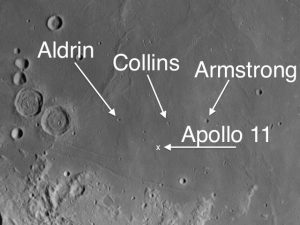 The week of February 4 – 10 takes us from New Moon to Day 5. This week we will highlight the crater Plinius and the Apollo 11 site, visible on Sunday evening.
The week of February 4 – 10 takes us from New Moon to Day 5. This week we will highlight the crater Plinius and the Apollo 11 site, visible on Sunday evening.
Plinius: [NE/H12] Standing sentinel between Tranquillity and Serenity is the crater Plinius, a fine object with a sharp rim, terraces, an ejecta blanket, and a central projection which, depending on the illumination, has been described variously as a mountain, a double-mountain, central craters, or low mounds. How does it strike you?
 Immediately to the north of Plinius are three prominent rilles (Rimae Plinius), which follow along the edge of the Serenity basin. The lava that filled Serenity was so heavy that it not only affected Posidonius and le Monnier [NE/F-G13], causing substantial sub-sidence, but over 200 miles away significant cracks opened up near Plinius.
Immediately to the north of Plinius are three prominent rilles (Rimae Plinius), which follow along the edge of the Serenity basin. The lava that filled Serenity was so heavy that it not only affected Posidonius and le Monnier [NE/F-G13], causing substantial sub-sidence, but over 200 miles away significant cracks opened up near Plinius.
Although the lavas covering Serenity have a brighter hue, can you see that the lava plains of Mare Tranquillitatis are darker and older? The coloring becomes suddenly lighter just north of Plinius.

 Apollo 11: [NE/J12] The best time to see the Apollo 11 landing site is around Day 5 (Sunday evening), or 4-5 days after full Moon. You will find the landing site just east of the crater Sabine. In the close-by neighborhood are three tiny craters named for the astronauts of Apollo 11: Aldrin, Collins, and Armstrong. These craters can be used to test your telescope optics and the seeing conditions. From west to east, the crater diameters are: Aldrin (2.1 miles), Collins (1.5 miles) and Armstrong (2.9 miles).
Apollo 11: [NE/J12] The best time to see the Apollo 11 landing site is around Day 5 (Sunday evening), or 4-5 days after full Moon. You will find the landing site just east of the crater Sabine. In the close-by neighborhood are three tiny craters named for the astronauts of Apollo 11: Aldrin, Collins, and Armstrong. These craters can be used to test your telescope optics and the seeing conditions. From west to east, the crater diameters are: Aldrin (2.1 miles), Collins (1.5 miles) and Armstrong (2.9 miles).
======================
It is highly recommended that you get a copy of Sky and Telescope’s Field Map of the Moon, the very finest Moon map available for use at the telescope. It is available for $10.95 at www.skyandtelescope.com and on Amazon. All features mentioned in this blog will be keyed to the grid on the Field Map and will look like this: Plato: [NW/D9]
Credits:
Courtesy of Gray Photography of Corpus Christi, Texas
Lunar photos: NASA / USGS / BMDO / LROC / ASU / DLR / LOLA / Moon Globe. Used by permission
- Rupes Cauchy: A Best Known Fault on the Moon - July 22, 2024
- Moon Crater Schickard – Crater Floor has Stripes - July 15, 2024
- Moon Craters Langrenus and Vandelinus - July 8, 2024
I ran across your website when I was trying to find some information about the crater Plinius and decided to contact you about some work. I have been doing over the past few years. I began taking photographs of the moon using a small digital camera that takes amazing pictures. It took me 2 1/2 years to get pictures of the moon for each of the 29 phase days. I built a database that includes the pictures I took for each of these phase days. I documented the features that I could see in each of these photographs in such a way that the user of the database can choose anyone feature and bring up a description of the feature, who or what it was named after, the LRO photo and other parameters. I would certainly love to share what I have with you in some way. If you are interested, please feel free to contact me. BTW I have documented over 350 individual features that I was able to see in my photographs.